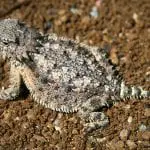Water Dragon Preparing to Lay Eggs
Video Credits: Dwayne F.
You can prepare water dragons for breeding by simply hibernating them. It’s a cooling-off period for these reptiles. Water dragons become sexually mature when they reach the age of 5. Male water dragons that are sexually mature should be at least 210 millimeters from their snout to vent. They should weigh 400 grams or even heavier.
Male water dragons below this size have very low testosterone levels. Sexually mature males have brighter throat coloring as well. Their throat can be striped or blotched with blue, yellow, or orange. If you want to make your water dragon lay eggs, you have to make sure that they have a wealthy weight, and they’re in good health.
Once you have a pair of healthy water dragons, you should get them checked by a vet. A deworming can increase the success rate of the breeding process and improve the health of the dragons as well. Sexually mature water dragons will mate without any light or temperature cycling. It’s also possible for females to lay eggs without mating with a male.
Hibernation Period
The water dragons’ photoperiod should be reduced from 12-14 hrs of daylight to 14 hrs of darkness and 10 hrs of daylight during the early winter or late autumn. Reduce the daytime temperature to 75-78 Fahrenheit. The area under the incandescent light should have a temperature of 80-84 Fahrenheit. The nighttime temperature should be reduced to 68-74 Fahrenheit.
You should also reduce the feeding schedule to once a week. Follow this routine for about 2 months. Put the water dragons back on the usual photoperiod of 12 hrs of light and temperature of 75-80 Fahrenheit during the night and 84-88 Fahrenheit during the day after the hibernation period.
How Do You Know that Your Water Dragons are Ready for Mating?
Dominant male water dragons will try to keep a territory and control a harem of females. They will also show territorial behavior towards other male water dragons by waving their arms, flicking their tails, bobbing their heads, fighting, and doing push-ups.
They scratch and bite using their claws and teeth as well as unbalance their enemy with their tail. Water dragons can also draw blood and lose their claws, tips, and toes due to fighting. Male water dragons will start displaying breeding behavior shortly after putting them back on their usual schedule.
The male will start chasing the female and move his head up and down. He will try to copulate by grasping the nuchal crest of the female between his teeth. The male will then twist her body to insert his hemipenis. Copulation usually lasts from 10 to 20 minutes.
Female water dragons may be injured or stressed if the male is relentless. If your female water dragon is injured or stressed, you should move her to another enclosure for some time until she has calmed down or completely healed.
Some people separate male water dragons from the female for a week and then re-introduce them during the breeding season to stimulate breeding behavior. Females may lay eggs even without copulating with a male water dragon. However, their eggs will not hatch if they have not mated with a male.
How do you know that your female water dragon has eggs? Her appetite will gradually diminish as her stomach grows. She will not be able to eat a lot because the eggs will press on her digestive system. As such, she will likely lose weight in her arms, tail, and legs. You have to make sure that your female water dragon gets enough calcium supplements.
There are various ways to give them extra calcium supplements. For instance, you can give liquid calcium drops to your female water dragon or add powdered calcium to her food. Female water dragons should be given extra calcium during the 2-month period to prevent calcium depletion in her body and to help with egg development.
What to Do When the Water Dragon Lays Eggs

Female water dragons lay eggs about 2 months after mating with a male. You will be able to feel 2 to 4 eggs on her stomach 2 to 3 weeks before she’s ready to lay the eggs. The eggs may also be visible on the female’s sides and will likely resemble jelly beans. You have to prepare a space inside the enclosure where she can lay her eggs.
Space should have either sandy peat moss or soil that’s 8″ to 10″ deep. The soil should be slightly moist. It should not be too dry or too damp. When your female water dragon starts digging, the soil will pile up well for her. As such, it is important to keep the soil moist enough that it won’t feel grainy and fall loose when you hold it in your hands.
If your female water dragon can’t find a suitable place, she may hold her eggs and suffer from dystocia or egg-binding, which is a serious condition. Dystocia can result in the death of the egg or hatchlings and inflammation of the female’s reproductive tract, which can cause decreased fertility or death of the water dragon.
When a female water dragon is about to lay her eggs, she may dig sporadically but not lay the eggs yet. However, you should just watch her closely because she will lay her eggs eventually. She may create a decoy hole as well.
How to Incubate the Eggs
Dig up the eggs carefully and pick them up without turning them. You have to pick up the eggs the way they’ve been deposited in the soil. Place the eggs in an incubator in moistened vermiculite. The ratio of vermiculite to water by volume should be 10:1.
The eggs should be placed 1″ or more apart to prevent the hatchlings from causing damage to the unhatched eggs. Two-thirds of the eggs should be hidden in the vermiculite, and one third should be exposed. You can put some moss over the visible part of the egg to keep it moist. Lightly spray the surface of the eggs with water every 2 days or so. Keep the eggs at 84 to 86 Fahrenheit.
If you want to build your own incubator, you have to add 3″ to 3.5″ of water to a 20-gallon tank. You also need a 75-watt aquarium heater that can be submerged in the water. A brick should be placed in the water so that you can put a plastic storage container on top of it. Add a vermiculite water mixture to the box and put a thermometer in the storage box. Set the right temperature for incubation. Put a lid on the tank for 1 hour between each tuning of the thermostat in order for you to get the right temperature.
Hatching time depends on various factors, such as the incubation temperature. Some eggs hatch 55 days after being laid, while others take 65 days or more. Watch the eggs carefully as the hatching time nears. Remove the hatchlings from the incubator and move them to a separate enclosure. You can put a floatation device or a piece of bark that the hatchlings can climb on when they come out of the egg. If you don’t want them to accidentally drown, you can cover the egg box with a screen material.
How to Care for Hatchlings
- Keep the hatchlings at 75 to 80 Fahrenheit at night and 84 to 88 Fahrenheit during the day. This is the same temperature required by adult water dragons. Provide water for drinking and bathing as well as incandescent lights for basking.
- You can give small mealworms or 2 to 3 week-old crickets to the hatchings. They can also eat finely chopped vegetables and fruits. You can give them larger food items as they grow older. They will also be able to eat other kinds of insects.
- Water dragons will do well in an arboreal-oriented enclosure with opaque sides and font. The enclosure should be heavily equipped with plants, perches, and vines. The minimum size of a cage for water dragons is 48″ to 72″ tall, 36″ to 48″ long and 16″ to 24″ deep.
- If you prefer an aquarium, you should use a 30-gallon tank for hatchlings and subadults and a 55-gallon enclosure for adults. Move young dragons to a larger enclosure as they mature because if you don’t, they won’t be able to grow properly. Stunting may occur.
You can also use a custom-built cage made of Plexiglas, smooth wood, glass, or soft mesh. It’s fun to build a vivarium on your own, especially if you have the patience and time for it. You can make a tropical haven using plastic plants and vines as well as horizontal and vertical tree limbs. Although real plants are a nice touch, they’re not a practical choice because they will be trashed by water dragons sooner or later. You can use treated lumber and sterilized tree limbs as perches. Soak tree limbs in a gentle bleach solution for about 20 minutes to sterilize them. Rinse the tree limbs well. As for the substrate, you can use orchid bark, reptile carpets, newspaper, cypress mulch, lizard litter, peat moss, or a combination of soil and sand.



